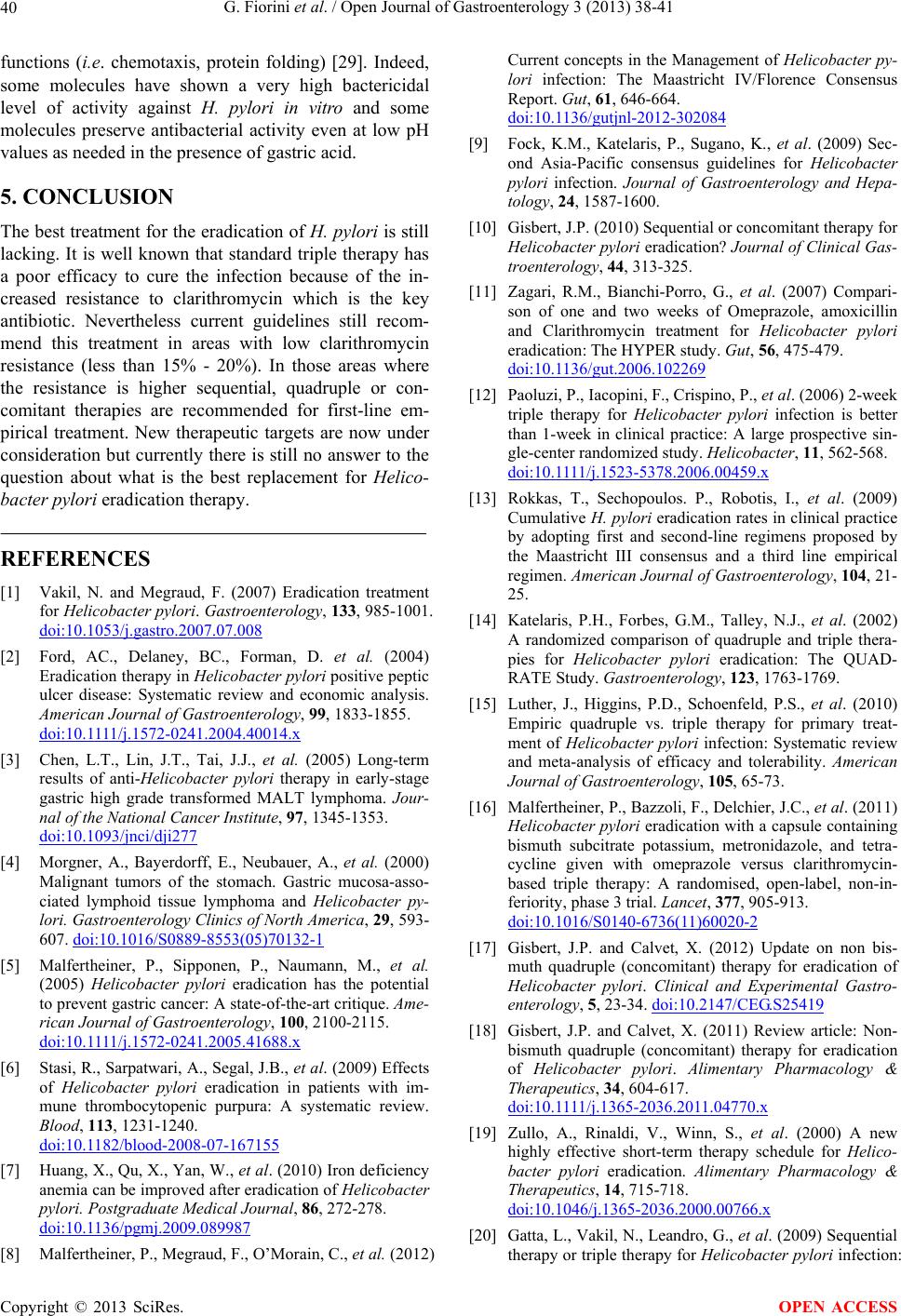
G. Fiorini et al. / Open Journal of Gastroenterology 3 (2013) 38-41
40
functions (i.e. chemotaxis, protein folding) [29]. Indeed,
some molecules have shown a very high bactericidal
level of activity against H. pylori in vitro and some
molecules preserve antibacterial activity even at low pH
values as needed in the presence of gastric acid.
5. CONCLUSION
The best treatment for the eradication of H. pylori is still
lacking. It is well known that standard triple therapy has
a poor efficacy to cure the infection because of the in-
creased resistance to clarithromycin which is the key
antibiotic. Nevertheless current guidelines still recom-
mend this treatment in areas with low clarithromycin
resistance (less than 15% - 20%). In those areas where
the resistance is higher sequential, quadruple or con-
comitant therapies are recommended for first-line em-
pirical treatment. New therapeutic targets are now under
consideration but currently there is still no answer to the
question about what is the best replacement for Helico-
bacter pylori eradication therapy.
REFERENCES
[1] Vakil, N. and Megraud, F. (2007) Eradication treatment
for Helicobacter pylori. Gastroenterology, 133, 985-1001.
doi:10.1053/j.gastro.2007.07.008
[2] Ford, AC., Delaney, BC., Forman, D. et al. (2004)
Eradication therapy in Helicobacter pylori positive peptic
ulcer disease: Systematic review and economic analysis.
American Journal of Gastroenterology, 99, 1833-1855.
doi:10.1111/j.1572-0241.2004.40014.x
[3] Chen, L.T., Lin, J.T., Tai, J.J., et al. (2005) Long-term
results of anti-Helicobacter pylori therapy in early-stage
gastric high grade transformed MALT lymphoma. Jour-
nal of the National Cancer Institute, 97, 1345-1353.
doi:10.1093/jnci/dji277
[4] Morgner, A., Bayerdorff, E., Neubauer, A., et al. (2000)
Malignant tumors of the stomach. Gastric mucosa-asso-
ciated lymphoid tissue lymphoma and Helicobacter py-
lori. Gastroenterology Clinics of North America, 29, 593-
607. doi:10.1016/S0889-8553(05)70132-1
[5] Malfertheiner, P., Sipponen, P., Naumann, M., et al.
(2005) Helicobacter pylori eradication has the potential
to prevent gastric cancer: A state-of-the-art critique. Ame-
rican Journal of Gastroenterology, 100, 2100-2115.
doi:10.1111/j.1572-0241.2005.41688.x
[6] Stasi, R., Sarpatwari, A., Segal, J.B., et al. (2009) Effects
of Helicobacter pylori eradication in patients with im-
mune thrombocytopenic purpura: A systematic review.
Blood, 113, 1231-1240.
doi:10.1182/blood-2008-07-167155
[7] Huang, X., Qu, X., Yan, W., et al. (2010) Iron deficiency
anemia can be improved after eradication of Helicobacter
pylori. Postgraduate Medical Journal, 86, 272-278.
doi:10.1136/pgmj.2009.089987
[8] Malfertheiner, P., Megraud, F., O’Morain, C., et al. (2012)
Current concepts in the Management of Helicobacter py-
lori infection: The Maastricht IV/Florence Consensus
Report. Gut, 61, 646-664.
doi:10.1136/gutjnl-2012-302084
[9] Fock, K.M., Katelaris, P., Sugano, K., et al. (2009) Sec-
ond Asia-Pacific consensus guidelines for Helicobacter
pylori infection. Journal of Gastroenterology and Hepa-
tology, 24, 1587-1600.
[10] Gisbert, J.P. (2010) Sequential or concomitant therapy for
Helicobacter pylori eradication? Journal of Clinical Gas-
troenterology, 44, 313-325.
[11] Zagari, R.M., Bianchi-Porro, G., et al. (2007) Compari-
son of one and two weeks of Omeprazole, amoxicillin
and Clarithromycin treatment for Helicobacter pylori
eradication: The HYPER study. Gut, 56, 475-479.
doi:10.1136/gut.2006.102269
[12] Paoluzi, P., Iacopini, F., Crispino, P., et al. (2006) 2-week
triple therapy for Helicobacter pylori infection is better
than 1-week in clinical practice: A large prospective sin-
gle-center randomized study. Helicobacter, 11, 562-568.
doi:10.1111/j.1523-5378.2006.00459.x
[13] Rokkas, T., Sechopoulos. P., Robotis, I., et al. (2009)
Cumulative H. pylori eradication rates in clinical practice
by adopting first and second-line regimens proposed by
the Maastricht III consensus and a third line empirical
regimen. American Journal of Gastroenterology, 104, 21-
25.
[14] Katelaris, P.H., Forbes, G.M., Talley, N.J., et al. (2002)
A randomized comparison of quadruple and triple thera-
pies for Helicobacter pylori eradication: The QUAD-
RATE Study. Gastroenterology, 123, 1763-1769.
[15] Luther, J., Higgins, P.D., Schoenfeld, P.S., et al. (2010)
Empiric quadruple vs. triple therapy for primary treat-
ment of Helicobacter pylori infection: Systematic review
and meta-analysis of efficacy and tolerability. American
Journal of Gastroenterology, 105, 65-73.
[16] Malfertheiner, P., Bazzoli, F., Delchier, J.C., et al. (2011)
Helicobacter pylori eradication with a capsule containing
bismuth subcitrate potassium, metronidazole, and tetra-
cycline given with omeprazole versus clarithromycin-
based triple therapy: A randomised, open-label, non-in-
feriority, phase 3 trial. Lancet, 377, 905-913.
doi:10.1016/S0140-6736(11)60020-2
[17] Gisbert, J.P. and Calvet, X. (2012) Update on non bis-
muth quadruple (concomitant) therapy for eradication of
Helicobacter pylori. Clinical and Experimental Gastro-
enterology, 5, 23-34. doi:10.2147/CEG.S25419
[18] Gisbert, J.P. and Calvet, X. (2011) Review article: Non-
bismuth quadruple (concomitant) therapy for eradication
of Helicobacter pylori. Alimentary Pharmacology &
Therapeutics, 34, 604-617.
doi:10.1111/j.1365-2036.2011.04770.x
[19] Zullo, A., Rinaldi, V., Winn, S., et al. (2000) A new
highly effective short-term therapy schedule for Helico-
bacter pylori eradication. Alimentary Pharmacology &
Therapeutics, 14, 715-718.
doi:10.1046/j.1365-2036.2000.00766.x
[20] Gatta, L., Vakil, N., Leandro, G., et al. (2009) Sequential
therapy or triple therapy for Helicobacter pylori infection:
Copyright © 2013 SciRes. OPEN ACCESS